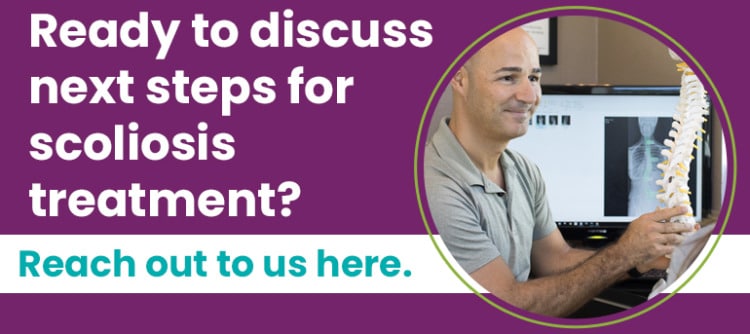When Does Idiopathic Scoliosis Require Treatment?

With progressive conditions like scoliosis, when treatment is started can be an important factor. Idiopathic scoliosis progression is triggered by growth, so children are the most at risk for continued and rapid progression. The more scoliosis progresses, the more complex it is to treat.
Idiopathic scoliosis isn't clearly associated with a single-known cause, but it can be highly responsive to treatment, especially with early diagnosis and intervention. Idiopathic scoliosis treatment should be started immediately following a diagnosis because its nature is to get worse.
Let's start by exploring some characteristics of idiopathic scoliosis.
Table of Contents
Idiopathic Scoliosis
Scoliosis causes the spine to bend unnaturally to the side and twist, and not only does the condition range widely in severity from mild idiopathic scoliosis to moderate scoliosis, severe, and very severe scoliosis, there are also different types.
The type of scoliosis is determined by its underlying cause, and when it comes to idiopathic scoliosis, we don't know what triggers its initial onset, but we know it's growth that makes it progress.
Idiopathic scoliosis is thought to be multifactorial: caused by a number of factors that vary from person to person, and what I remind patients recently diagnosed is that not knowing its cause isn't as important as knowing how to respond with treatment.
Idiopathic scoliosis diagnosed as mild idiopathic scoliosis means early detection was achieved, and this means early intervention is possible, and while there are no treatment guarantees, there is a connection between early detection, intervention, and treatment success.
Idiopathic scoliosis is the most common type of scoliosis to affect all ages, so let's talk about the main differences between idiopathic scoliosis in children and idiopathic scoliosis diagnosed in adulthood.
Childhood Idiopathic Scoliosis
Childhood scoliosis should always be taken seriously as it is the leading spinal condition among school-aged children, and progression is triggered by growth.
Idiopathic scoliosis can affect infants as infantile scoliosis diagnosed between the ages of 6 months old and 3 years of age, juvenile scoliosis diagnosed between 3 and 10, and adolescent idiopathic scoliosis diagnosed between the ages of 10 and reaching skeletal maturity.
Adolescent idiopathic scoliosis is the most prevalent type overall, and this is the type most at risk for rapid progression because of puberty and its rapid and unpredictable growth spurts.
The main effect of childhood scoliosis is postural deviation caused by the condition's uneven forces disrupting the body's overall symmetry.
Postural Changes
 The earliest signs of childhood scoliosis are often uneven shoulders and uneven hips, but these signs can be subtle, especially when mild.
The earliest signs of childhood scoliosis are often uneven shoulders and uneven hips, but these signs can be subtle, especially when mild.
But scoliosis that's diagnosed as mild means the spine is still flexible, significant progression hasn't yet occurred, and this is the best time to start treatment.
The earlier treatment is started, the less likely it is that continued progression will lead to a recommendation for scoliosis surgery.
The earlier treatment is started, the more it's likely to successfully counteract the condition's progressive nature, despite the constant progressive trigger of growth occurring.
As idiopathic scoliosis progresses, additional changes to gait, balance, and coordination are also common.
Childhood scoliosis isn't commonly painful because the condition doesn't become compressive until skeletal maturity has been reached, but pain is the main symptom of adult scoliosis.
Adult Idiopathic Scoliosis
Adult scoliosis is diagnosed once growth has stopped and skeletal maturity has been reached, and this is important not just in terms of progression, but also pain.
When growth is occurring, the constant lengthening motion of a growing spine counteracts the compressive force of the unnatural spinal curve, so the lack of pain in childhood scoliosis is a barrier to early detection, but scoliosis pain is the main symptom that brings adults in to see me for assessment.
The main type of scoliosis to affect adults is idiopathic scoliosis, but what's important to understand is these are cases of adolescent idiopathic scoliosis that were undiagnosed and untreated during adolescence, progressing with time and growth.
It's not an uncommon scenario that adolescents live with scoliosis unaware while they are growing, but once skeletal maturity is reached and conditions become compressive, painful, and more noticeable, adult patients notice something is wrong.
Mild scoliosis has mild symptoms and isn't associated with functional deficits, so it can be difficult to notice, and particularly when it comes to adolescents, this age group often wants to conceal postural changes and will try to compensate.
The unfortunate reality is had these patients gotten treatment when they were young, rather than in adulthood, their spines would be in far better shape; it's generally more effective to proactively work towards preventing progression and increasing effects than it is to work towards reversing changes once they've become established.
The best way to avoid surgical treatment is to treat conditions proactively, and this means starting treatment as close to the time of diagnosis as possible.
Benefits of Proactive Scoliosis Treatment
There are a number of benefits associated with a proactive treatment approach, and working towards stopping curve progression is key because this means sparing patients the hardships associated with increasing condition severity and the need for scoliosis surgery in the future.
Proactive treatment is started immediately following a diagnosis because as a progressive condition, we know that virtually all cases of scoliosis, regardless of how mild they are when diagnosed, are likely to get worse at some point.
Avoiding Surgical Treatment
Spinal fusion surgery is invasive, and while traditional treatment commonly recommends watching and waiting while conditions are mild, from a proactive standpoint, this is wasting valuable treatment time.
Scoliosis screening can help achieve early detection, but of course the benefits of early detection are only available to those committing to a proactive conservative treatment response.
Progression makes the spine increasingly rigid and less responsive to treatment: a benefit of starting treatment early.
Progression also causes more overt postural changes and disruptions to movement: another benefit to starting treatment early and preventing increasing condition effects.
The more severe a condition becomes, the more likely it is that invasive surgical treatment will be needed in the future, and spinal surgery always comes with serious potential risks, side effects, and complications.
The truth is that traditional scoliosis treatment doesn't have a strategy for addressing scoliosis while mild, which is why it recommends watching and waiting until enough progression has occurred to warrant a surgical recommendation, but little is done beforehand in terms of prevention.
Conservative Non-Surgical Treatment
 Here at the Scoliosis Reduction Center®, patients benefit from a proactive conservative non-surgical treatment approach with proven results.
Here at the Scoliosis Reduction Center®, patients benefit from a proactive conservative non-surgical treatment approach with proven results.
Conservative treatment for idiopathic scoliosis works towards preventing progression, increasing condition effects, and the need for surgical treatment.
Conservative treatment for idiopathic scoliosis is also integrative; it combines the power of scoliosis-specific chiropractic care, physical therapy, scoliosis exercises, corrective bracing, and rehabilitation.
A child's spine is more flexible and responsive, but it is also more vulnerable to rapid progression as a child grows.
Particularly when addressing childhood scoliosis, early detection is beneficial because it can mean starting treatment before the first significant pubescent growth spurt, when conditions can be highly responsive.
Conservative treatment options are customized to address important factors such as patient age, condition type, severity, and curvature location; the different treatment disciplines are apportioned accordingly and adjusted based on how the spine is responding to treatment and growth.
Conservative treatment offers a less invasive alternative to traditional spinal fusion surgery, and the approach prioritizes preserving as much of the spine's natural strength and function as possible.
Conclusion
All cases of scoliosis can benefit from treatment, and as a progressive condition, where a patient's scoliosis is at the time of diagnosis doesn't mean that's where it will stay; only proactive treatment can work towards counteracting the condition's progressive nature.
The most important thing to understand about scoliosis treatment is that the earlier it's started, the better, and the longer scoliosis is left untreated, the more severe it's likely to become, and the more likely future surgical treatment becomes.
Spinal fusion is known to weaken the spine, make the spine less flexible, and can cause increased pain at the fusion site; a weaker spine is one that's more vulnerable to injury and less functional.
We don't know what causes idiopathic scoliosis to develop, but we know how to respond with treatment, and when to respond: immediately following a diagnosis.
Mild scoliosis can easily become moderate scoliosis, severe scoliosis, and very severe scoliosis without treatment, so the sooner treatment is started, the better.
Diagnosing idiopathic scoliosis involves a physical examination, taking the patient's family history and medical history, performing an Adam's forward bend test, and the results of a scoliosis X-ray.
Once diagnosed, it's important to start treatment immediately because this is when conditions are at their mildest; progression only makes them more complex to treat.
Dr. Tony Nalda
DOCTOR OF CHIROPRACTIC
After receiving an undergraduate degree in psychology and his Doctorate of Chiropractic from Life University, Dr. Nalda settled in Celebration, Florida and proceeded to build one of Central Florida’s most successful chiropractic clinics.
His experience with patients suffering from scoliosis, and the confusion and frustration they faced, led him to seek a specialty in scoliosis care. In 2006 he completed his Intensive Care Certification from CLEAR Institute, a leading scoliosis educational and certification center.
About Dr. Tony Nalda
 Ready to explore scoliosis treatment? Contact Us Now
Ready to explore scoliosis treatment? Contact Us Now





